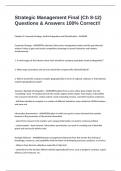Strategic Management Final (Ch 8-12)
Questions & Answers 100% Correct!!
Chapter 8: Corporate Strategy: Vertical Integration and Diversification - ANSWER
Corporate Strategy - ANSWERThe decisions that senior management makes and the goal-directed
actions it takes to gain and sustain competitive advantage in several industries and markets
simultaneously
1. In what stages of the industry value chain should the company participate (vertical integration)?
2. What range of products and services should the company offer (diversification)?
3. Where should the company compete geographically in terms of regional, national, or international
markets (geographical scope)?
Amazon's Example of Integration - ANSWERMorphed from a mere online book retailer into the
"everything" store. IT transformed into the world's largest online retailer. From books, it diversified
into consumer electronics, media content, cloud computing services, and other business endeavors.
- Jeff Bezos decided to compete in a number of different industries, some related to AMZNs business
and some not
Information Asymmetries - ANSWERSituation in which one party is more informed than another
because of the possession of the private information
- when firms transact in the market, such unequal information can lead to a lemons problem
- caveat-emptor - buyer beware. Information asymmetries can result in crowding out of desirable
goods and services by inferior ones.
Strategic Alliances - ANSWERVoluntary arrangements between firms that involve the sharing of
knowledge, resources, and capabilities with the intent of developing processes, products, or services.
- alliances have become ubiquitous especially in high tech
- umbrella term the denotes different hybrid organizational forms, such as longterm contracts, equity
alliances, joint ventures, etc.
,Why Do Firms Need To Grow? - ANSWER1. Increase Profits
2. Lower Costs
3. Increase Market Power
4. Reduce Risk
5. Motivate Management
Three Dimensions of Corporate Strategy - ANSWER1. Vertical Integration
2. Diversification
3. Geographical Scope
Core Competencies: unique strengths embedded deep within a firm
- allow a firm to differentiate its products and services from those of its rivals, creating higher value
for the customer or offering products and services of comparable value at lower cost
Economies of Scale: occur when a firm's average cost per unit decreases as its output increases.
Given size, a large company can spread its fixed costs over the millions of G/s it produces, gaining
more buying power and larger market share because of it
Economies of Scope: savings that come from producing two (or more) outputs or providing different
services at less cost than producing individually, though using the same resources and technology
- leveraging this can be beneficial to offer services at a lower cost together than it would individually
(ex: amazon offering large range of products online, lower than than offering each product
individually)
Transaction Costs: all costs associated with an economic exchange. Concept is developed in
transaction cost economics, a strategic management framework, and enables managers to answer
the question of whether or not is is cost-effective for their firm to expand its boundaries through
vertical integration or diversification.
Transaction Costs - ANSWERall internal and external costs associated with an economic exchange,
whether within a firm or in markets
1. External Transaction Costs: costs of searching for a firm or an individual with whom to contract,
and then negotiating, monitoring, and enforcing the contract
, 2. Internal Transaction Costs: costs pertaining to organizing an economic exchange: aka recruiting
and retaining employees, paying salaries and benefits, administrative, etc.
Transaction Cost Economics: explains and predicts the boundaries of the firm. Insights gained help
managers decide what to do in house versus what services and products to obtain from the external
market
Principal-Agent Problem - ANSWERMajor disadvantage of organizing economic activity within firms,
as opposed to within markets.
- can arise when an agent such as a manager, performing activities on behalf of the principal (owner),
pursues his or her own interests
- high powered incentives, increased flexibility, search costs, opportunism by other parties,
incomplete contracting, enforcement of contracts
Parent-Subsidary Relationship - ANSWERDescribes the most-integrated alternative to performing an
activity within ones own corporate family. The corporate parent owns the subsidiary and can direct it
via command and control
- transaction costs that arise are frequently due to political battle turns, capital budgeting, etc
Industry Value Chain - ANSWERDepiction of the information of raw materials into finished goods and
services along distinct vertical stages, each of which typically represents a distinct industry in which a
number of different firms are competing
1. Backward Vertical Integration: changes in an industry value chain that involve moving ownership of
activities upstream to the originating (inputs) point of the value chain
2. Forward Vertical Integration: changes in an industry value chain that involve moving ownership of
activities closer to the end (customer) point of the value chain
Specialized Assets - ANSWERUnique assets with high opportunity cost: they have significantly more
value in their intended use than in their next best use. They come in three types: site specificity,
physical asset specificity, and human-asset specificity
1. Site Specificity: assets required to be co-located, such as equipment necessary for mixing bauxite
and aluminum smelting




